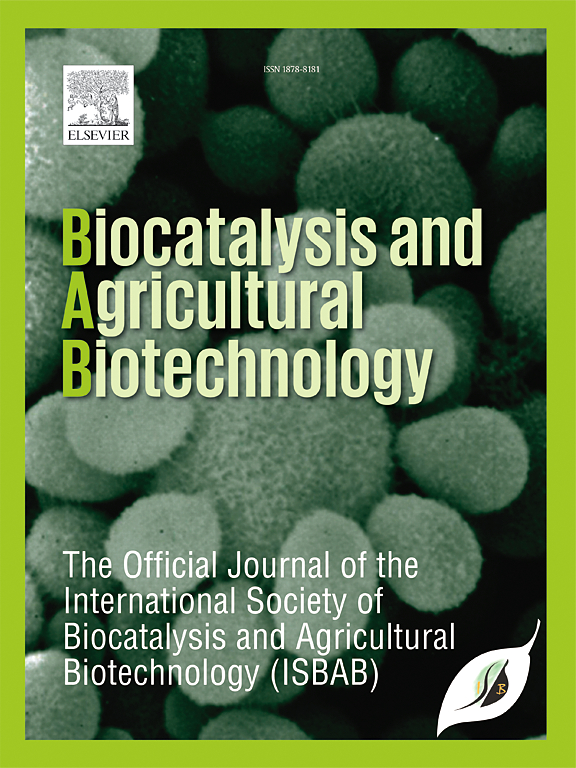Spent broth of Micromonospora sp. TBJPDA3, a sporocarp bacterium of Calocybe indica, improved mushroom spawning in sawdust substrate
IF 3.8
Q2 BIOTECHNOLOGY & APPLIED MICROBIOLOGY
引用次数: 0
Abstract
Calocybe indica is a potential tropical edible mushroom with an attractive taste and a high nutritional value. To obtain a desired harvest, the mycelia should be spawned in the entire sawdust substrate before proceeding to the next step. However, the spawning rate of this mushroom is considerably low. Recently, bacteria isolated from the sporocarp of mushrooms attracted many attentions due to their ability to specifically promote the mycelial growth of their fungal host via the production of metabolites. Therefore, the aim of this study was to accelerate the spawning run of C. indica by using a crude extract of its sporocarp bacterial metabolite. Two isolates with a significant mycelial growth promotion were employed, namely TBJPDA3 and TBJPDA4. The spent broth (SB) of TBJPDA3 and TBJPDA4 significantly stimulated the mycelial growth of C. indica in agar plate by 26.85 and 18.33 %, respectively. In sawdust medium, the SB of TBJPDA3 increased 28.83 % of the mycelial growth. Furthermore, the presence SB of TBJPDA3 in sawdust substrate also increased 26.13, 100.00, and 30.98 % of laccase, lignin peroxidase, and manganese peroxidase activity of the fungus, respectively. The strain of TBJPDA3 was molecularly identified as Micromonospora sp. The untargeted metabolomic toward SB of TBJPDA3 showed collection of some potential carbonecous and nitrogenous compounds. In conclusion, Micromonospora sp. TBJPDA3 and its metabolites were prospective for sustainable C. indica cultivation through accelerating bioconversion of sawdust substrate.
小单孢子菌TBJPDA3的废肉汤对木屑基质上的蘑菇产卵有促进作用
甘露菇是一种极具开发潜力的热带食用菌,具有良好的风味和较高的营养价值。为了获得理想的收获,菌丝体应该在整个木屑基质中繁殖,然后再进行下一步。然而,这种蘑菇的产卵率相当低。近年来,从蘑菇孢子皮中分离出来的细菌由于能够通过产生代谢物特异性地促进真菌宿主的菌丝生长而引起了人们的广泛关注。因此,本研究的目的是利用其孢子囊细菌代谢物的粗提物来加速籼稻的产卵运行。采用两株促进菌丝生长的菌株TBJPDA3和TBJPDA4。TBJPDA3和TBJPDA4的废肉汤对酵母菌丝生长的促进作用分别为26.85%和18.33%。在木屑培养基中,TBJPDA3的SB可使菌丝生长提高28.83%。此外,TBJPDA3在木屑底物中的存在也使真菌的漆酶、木质素过氧化物酶和锰过氧化物酶活性分别提高26.13%、100.0%和30.98%。菌株TBJPDA3经分子鉴定为小单孢菌,对SB的非靶向代谢组学分析显示,该菌株收集了一些潜在的碳、氮化合物。综上所述,TBJPDA3及其代谢产物通过加速木屑底物的生物转化,具有可持续培养籼稻的潜力。
本文章由计算机程序翻译,如有差异,请以英文原文为准。
求助全文
约1分钟内获得全文
求助全文
来源期刊

Biocatalysis and agricultural biotechnology
Agricultural and Biological Sciences-Agronomy and Crop Science
CiteScore
7.70
自引率
2.50%
发文量
308
审稿时长
48 days
期刊介绍:
Biocatalysis and Agricultural Biotechnology is the official journal of the International Society of Biocatalysis and Agricultural Biotechnology (ISBAB). The journal publishes high quality articles especially in the science and technology of biocatalysis, bioprocesses, agricultural biotechnology, biomedical biotechnology, and, if appropriate, from other related areas of biotechnology. The journal will publish peer-reviewed basic and applied research papers, authoritative reviews, and feature articles. The scope of the journal encompasses the research, industrial, and commercial aspects of biotechnology, including the areas of: biocatalysis; bioprocesses; food and agriculture; genetic engineering; molecular biology; healthcare and pharmaceuticals; biofuels; genomics; nanotechnology; environment and biodiversity; and bioremediation.
 求助内容:
求助内容: 应助结果提醒方式:
应助结果提醒方式:


